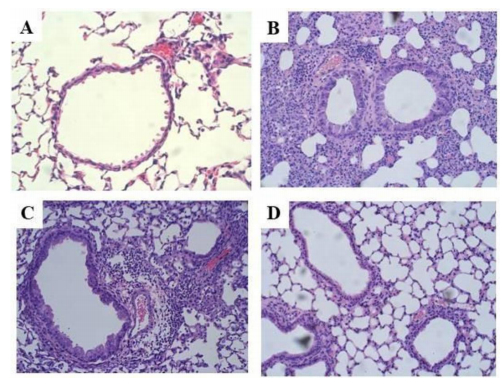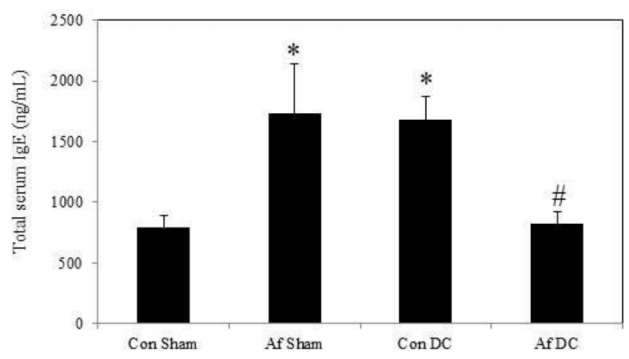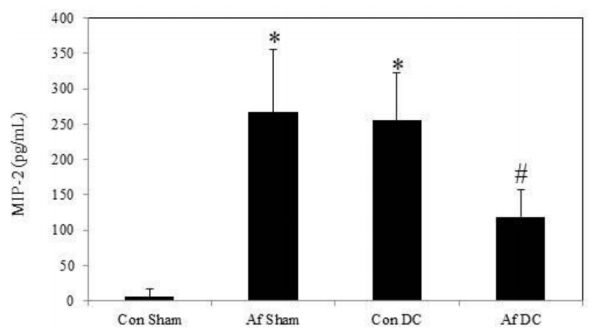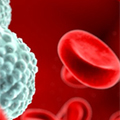1. Introduction
Bronchial asthma is a representative airway inflammatory disorder, involving various inflammatory cells and mediators in its pathogenesis [1,2]. Since human airways are directly connected to the atmosphere, numerous airborne factors continuously contact the airway during breathing and some of them can potentially develop or exacerbate allergic airway inflammation of asthma. Respiratory infections are the most frequent cause of asthma exacerbation in both children and adults [3,4]. Among respiratory pathogens, the role of fungi in the pathogenesis of asthma has been long established. Aspergillus fumigatus (Af) is a ubiquitous saprophytic mold that forms airborne spores (conidia). Af conidia are easily cleared from the airway of healthy individuals, while they occasionally cause several respiratory diseases based on host immunity. In immunocompromised hosts, Af causes severe infectious disease including chronic pulmonary aspergillosis and invasive pulmonary aspergillosis. In contrast, Af causes allergic bronchopulmonary aspergillosis (ABPA) and severe asthma with fungal sensitization (SAFS) in allergic individuals. SAFS has been coined to define a particular phenotype of severe asthma despite the use of high-dose inhaled corticosteroids and long-acting bronchodilators [5]. Although antifungal treatments are available for SAFS, the effects of antifungal treatments for SAFS remain inconclusive [6,7]. Thus a new therapeutic modality is required for SAFS.
Dendritic cells (DCs) are the most potent antigen-presenting cells in the airways and determine the type of T cell-mediated immune response. DCs thus play a central role in initiating both allergy and infection [8,9,10,11]. In both humans and mice, several subtypes of DCs, characterized by surface markers and function, have been described. Generally, DCs can be distinguished as either myeloid DCs (mDCs) or plasmacytoid DCs (pDCs) [12]. It is likely that mDCs are collectively important for generating T cell division and priming, and respiratory viruses can directly infect mDCs to modulate their immunological properties [13]. In contrast, pDCs possess only a modest capacity to activate naive T cells and have been demonstrated to be specialized in the production of high levels of IFN-α/β in response to various viruses both in humans and mice [14,15,16]. It has been reported that pDCs have an essential immunoregulatory role in the lung that protects against the development of airway inflammation towards harmless antigens in mice [17]. Focusing on the immunoregulatory profile of pDCs, the purpose of the present study was to investigate the effects of intranasal transfer of pDCs to a murine model of Af sensitized and infected asthma, mimicking SAFS, on airway inflammation and cytokine profiles.
2. Methods
2.1. Mice
Female BALB/c mice, 4–6 weeks of age, free of specific pathogens, were purchased from Charles River Laboratories (Yokohama, Japan). They were housed under pathogen-free conditions at the Laboratory Animal Center for Biochemical Research, Nagasaki University School of Medicine. All experimental procedures were reviewed and approved by the Nagasaki University School of Medicine Committee on Animal Research. Experiments were repeated at least three times.
2.2. Preparation of Af conidia
Af MF-13, which was isolated from the sputum of a patient with pulmonary aspergilloma, was prepared to induce intranasal infections, as previously described [18]. Af MF-13 was subcultured on Sabouraud dextrose agar (Becton Dickinson, Cockeysville, MD, USA) at 30 ℃ for 7 days. The conidia were then harvested with sterile saline containing 0.02% Tween 80 (Wako Pure Chemical Industries, Tokyo, Japan). The suspensionwas filtered through a 40-µm cell strainer (BD Falcon, Tokyo, Japan) toseparate conidia from the contaminated mycelium and verifiedmicroscopically (100% resting conidia). The suspension was then counted in a hemocytometer and diluted with sterile saline.
2.3. Preparation of pDCs from Af sensitized and infected donor mice
Two groups of donor mice were prepared: Control and Af allergen sensitized and infected (Af) mice. Control mice were injected twice intraperitoneally (i.p.) on days 1 and 14 with phosphate-buffered saline (PBS) and then inoculated intranasally (i.n.) with 50 μL of PBS once a day on days 14–16. Af mice were immunized twice i.p. on days 1 and 14 with 20 μL/mouse of Af allergen (NA-AF1-2, Funakoshi Co., Ltd., Tokyo, Japan) precipitated in aluminum hydroxide and then infected i.n. with 50 μL of 5 × 106 live Af conidia once a day on days 14-16. Donor mice were sacrificed by cervical dislocation on day 17, followed by dissection of spleen tissue. For splenic pDC isolation, spleen tissues were injected with 500 μL of Collagenase D (Boehringer-Mannheim, Mannheim, Germany) solution per spleen. The tissue was then cut into small pieces and incubated in Collagenase D solution for 30 min at 37 ℃. Splenic cells were mechanically filtered through a 250-μm mesh, and further purified over a Ficoll (Amersham Biosciences, Uppsala, Sweden) gradient by suspending the cells in a 10-mL solution of 1.075 g/mL high-density Ficoll and centrifuging at 1,500 rpm for 10 min. Low-density cells were collected, resuspended, and washed in RPMI 1640 (Gibco, Grand Island, NY, USA) supplemented with 1% fetal bovine serum and 0.1% penicillin-streptomycin (Gibco) (hereafter referred to as cRPMI). Splenic pDCs isolated from Control and Af mice were purified by magnetic cell sorting (MACS Technology) using the Plasmacytoid Dendritic Cell Isolation kit (Miltenyi Biotec, Bergisch Gladbach, Germany) according to the manufacturer's protocol. Splenic cells were incubated with anti-CD3, anti-CD19, anti-CD11b and anti-CD49b antibody-MicroBeads and passed through a negative selection LD column with a MidiMACS magnet. The collected unlabeled cells were then incubated with anti-CD45R (B220) antibody-MicroBeads and passed through a positive selection LS column with a MiniMACS magnet. Cell viability was assessed, in triplicate, by trypan blue exclusion after 48 h. The isolated splenic pDCs were sorted based on their expression of PDCA-1 and CD11c using specific antibodies (Miltenyi Biotec) and the BD FACSCanto Ⅱ system (Becton Dickinson, Oakville, Canada). The pDC population was ≥90% pure in three independent experiments.
2.4. In vivo transfer of pDCs to Af sensitized and infected recipient mice
Four groups of recipient mice were prepared: Control mice sham transferred with cRMPI (Con Sham), Af mice sham transferred with cRPMI (Af Sham), Af mice transferred with pDCs from donor control mice (Con DC), and Af mice transferred with pDCs from donor Af mice (Af DC). Con Sham and Af Sham mice were prepared similarly as donor control and Af mice, respectively. Mice were sham transferred i.n. with cRPMI on day 1. Purified splenic pDCs from donor mice were washed and resuspended in cRPMI. Isolated pDCs from donor control or Af mice were inoculated i.n. at a concentration of 4 × 105 cells, in a volume of 100 µL/mouse, into Con DC or Af DC mice on day 1, respectively. Thereafter, both Con DC and Af DC mice were sensitized and infected with Af similar to donor Af mice. Recipient mice were sacrificed by cervical dislocation on day 17 and blood and lung tissue were obtained for total serum IgE determination and pathology, respectively.
2.5. Determination of total serum IgE level
The serum concentrations of total IgE were measured in duplicate by enzyme-linked immunosorbent assay (ELISA). The total serum IgE concentration was determined using a rat anti-mouse IgE antibody (PharMingen, San Diego, CA, USA) and biotin-conjugated rat anti-mouse IgE monoclonal antibody (PharMingen) as previously described [19]. The total serum IgE level was expressed as μg/mL using a mouse IgE standard (PharMingen).
2.6. Analysis of cytokine concentrations in homogenized lung
Lung homogenates were prepared by homogenizing a freshly excised lung. MIP-2 (murine cytokine corresponding to human IL-8), IL-5, IL-10, IL-17 and IFN-γ concentrations in homogenized lung samples were measured by ELISA according to the manufacturer's instructions (Endogen, Woburn, MA, USA).
2.7. Statistical analysis
The results are expressed as the mean ± SEM. Differences between groups were examined for statistical significance using repeated measures analysis of variance with Bonferroni's multiple comparison test. A p value of less than 0.05 was considered significant.
3. Results
3.1. Lung pathology
Representative photographs of hematoxylin and eosin stained lungs are shown in Figure 1. In comparison with Con Sham mice, lung tissue from Af Sham mice exhibited both eosinophilic and neutrophilic airway inflammation. Intranasal transfer of pDCs isolated from control mice did not show any effects on lung tissue of Con DC mice. In contrast, pDCs isolated from Af sensitized and infected mice inhibited both eosinophilic and neutrophilic airway inflammation in Af DC mice.
3.2. Total serum IgE levels
Compared with Con Sham mice, total serum IgE levels were significantly increased in Af Sham mice. Intranasal transfer of pDCs isolated from control mice did not significantly decrease total serum IgE levels in Con DC mice, whereas pDCs isolated from Af sensitized and infected mice significantly reduced total serum IgE levels in Af DC mice (Figure 2).
3.3. Cytokine profiles in lung tissue
In comparison with Con Sham mice, concentrations of proinflammatory cytokines, MIP-2, IL-5 and IL-17, were significantly increased in Af Sham and Con DC mice. These proinflammatory cytokines were significantly inhibited in Af DC mice (Figures 3 and 4). However, significant differences were not observed for IFN-γ, a critical cytokine for innate immunity (Figure 3). Additionally, IL-10 concentrations, an immunoregulatory cytokine, were significantly increased in Af DC mice compared with Af Sham and Con DC mice (Figure 5).
4. Discussion and Conclusion
Major findings of the present study are as follows: intranasal transfer of pDCs isolated from Af sensitized and infected donor mice to Af sensitized and infected recipient mice (ⅰ) attenuated both eosinophilic and neutrophilic airway inflammation, (ⅱ) reduced total serum IgE levels and (ⅲ) inhibited proinflammatory cytokines and increased immunoregulatory cytokines but did not alter the IFN response in lung tissues.
We found that Af infection enhanced both eosinophilic and neutrophilic airway inflammation in Af allergen sensitized mice, which is in agreement with our previous report in Af infected and mite allergen sensitized mice [18,20]. A key characteristic of fungal-associated asthma is its increased severity [21,22,23]. Although the mechanism remains unclear, fungi may have a much greater impact on asthmatics by triggering immune defense and producing toxins and enzymes that may play an accessory role in triggering allergy [5]. Although ABPA is characterized by eosinophilia, it has also been correlated with increased sputum neutrophils and increased levels of IL-8 [24]. The detection of Af in sputum is associated with sputum neutrophils and reduced lung function [25]. Neutrophilic airway inflammation caused by Af may at least partially explain the increased severity of fungus-associated asthma, since inhaled corticosteroids, an anti-inflammatory drug, have little or no impact on neutrophilic airway inflammation [26,27]. Therefore, additive treatment, which has an impact on neutrophilic inflammation, is required for fungus-associated asthma. Accordingly, antifungal drugs have gained increasing attention, and itoraconazole was reported to improve asthma-related quality of life in SAFS [6]. However, voriconazole, another antifungal drug, failed to inhibit acute exacerbation in SAFS [28]. Thus, the effects of antifungal drugs for the treatment of SAFS are inconclusive. Another clinical concern with utilizing corticosteroids for SAFS is the inhibition of innate immunity against fungi. We previously reported that phagocytosis against Af by alveolar macrophages (AM) was significantly reduced in dexamethasone treated naive mice [20]. AM are the main phagocytotic cells in the lungs with innate immunity against Af and their phagocytotic activity can be attenuated by corticosteroids [29]. Collectively, a therapeutic modality for SAFS that can regulate both eosinophilic and neutrophilic airway inflammation without inhibiting innate immunity is needed. Although fungal burden was not determined in the present study, lung pathology did not indicate exacerbated fungal infection in pDC transferred mice, suggesting antifungal immunity was maintained.
Intranasal transfer of mite allergen-pulsed murine bone marrow-derived mDCs enhances allergic airway inflammation, indicating that mDCs promote allergy [30,31]. In contrast, depletion of pDCs during allergen inhalation resulted in the enhancement of type 2 T helper cell-mediated allergic airway inflammation. Furthermore, adoptive transfer of pDCs prior to allergen sensitization prevented allergic airway inflammation [32]. These data suggest that pDCs have a protective role against allergy and lung pathology, which was confirmed in the present study. We had previously shown that adoptive transfer of mite allergen sensitized pDCs mediate tolerance to inhaled mite allergens through the induction of IL-10, Treg and a decrease in the number of mDCs [33]. Although the present study could not address the exact mechanisms, Af sensitized pDCs potentially act through similar mechanisms. Additionally, macrophages might also synergistically induce tolerance with pDCs in the lung or lung draining lymph nodes [34]. To clarify the underlying mechanisms of pDCs in the preventing Af induced allergic airway inflammation, the cellular kinetics of transferred pDCs in the lung or lung draining lymph nodes should be definitely demonstrated in the future study. The cytokine profiles of lung homogenates demonstrated that pDCs significantly decreased proinflammatory cytokines, MIP-2, IL-5 and IL-17, and increased an immunoregulatory cytokine, IL-10, without affecting IFN-γ. These results indicate that in contrast to corticosteroids, which nonselectively inhibit the immune response, pDCs selectively inhibit eosinophilic and neutrophilic proinflammatory responses while upregulating immunoregulatory responses and maintaining IFN-associated antifungal responses.
In conclusion, the present study showed that pDCs are potent inhibitors of the development of allergic airway inflammation in SAFS. Transfer of pDCs into the airway of asthmatics could be an effective and safe therapeutic modality for SAFS.
Acknowledgements
This study was supported by Grants-in-Aid for Scientific Research from the Japanese Ministry of Education, Culture, Sports, Science and Technology (Nos. 17607009,21590968 and 25461161) and a Research Grant on Allergic Disease and Immunology from Japan Agency for Medical Research and Development.
Conflict of Interest
All authors declare no conflicts of interest in relation to this article.










 DownLoad:
DownLoad: 











